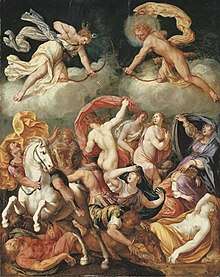Bernardino Cesari
Bernardino Cesari (1571 – 30 June 1622)[1] was an Italian painter of the late-Mannerist and early Baroque period, active mainly in Rome and Naples, where he assisted his brother Giuseppe Cesari (Cavaliere d'Arpino).

On 9 November 1592, he was sentenced to death, for consorting with bandits, and fled to Naples. On 13 May 1593, he was pardoned and returned to Rome.[2] In 1616, he travelled with Giuseppe to Naples to assist in painting in the Certosa di San Martino, then to Piedimonte di Alife to paint a large Last Judgement in the chapel of the fathers "predicatori". He traveled to Monte Cassino where he labored with Giuseppe in the frescoes for the refectory and the stanza of San Benedict, then to Rome where he painted an oil canvas of Noli me tangere, a fresco of Constatine the great, a St. Peter, and three oil paintings for the church Santi Cosma e Damiano.
Works
- Destruction of Niobe's Children
- Hannibal's Defeat by Scipio Africanus
- Noli me tangere
- Persephone and Andromeda
- St. Peter, Santi Cosma e Damiano
- St. Cecilia
- Diana and Acteon
- Sts. Stephen and Agatha
- A fresco of Constantine the Great
- Painitngs at Certosa di San Martino, Naples
References
- "Cesari, Bernardino". Rijksbureau voor Kunsthistorische Documentatie. Retrieved 15 November 2013.
- Langdon, Helen (2000). Caravaggio: A Life. Westview Press. ISBN 9780813337944.
| Wikimedia Commons has media related to Bernardino Cesari. |
Bibliography
His biography is collected in Giovanni Baglione's Vite. p. 139.
- Hobbes, James R. (1849). Picture collector's manual adapted to the professional man, and the amateur. T&W Boone, 29 Bond Street; Digitized by Googlebooks. p. 49.
- Minieri-Riccio, Camillo (1844). Memorie storiche degli scrittori nati nel regno di Napoli. Tipografia dell'Aquila di V. Puzziello, Chiostro di San Tomasso d'Aquino, Naples; Digitized by Googlebooks April 18, 2006. p. 95.